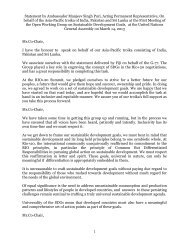STATE OF THE WORLD'S CITIES 2012/2013 Prosperity
STATE OF THE WORLD'S CITIES 2012/2013 Prosperity
STATE OF THE WORLD'S CITIES 2012/2013 Prosperity
You also want an ePaper? Increase the reach of your titles
YUMPU automatically turns print PDFs into web optimized ePapers that Google loves.
State of the World’s Cities <strong>2012</strong>/<strong>2013</strong><br />
It holds the five ‘spokes’ together and endeavours to<br />
maintain their balance and symmetry.<br />
MEASURING PROSPERITy: ATTEMPTS,<br />
FAILURES AND PROGRESS<br />
<strong>Prosperity</strong> remains one of humankind’s most enduring<br />
pursuits across time and space. But it is only in the past<br />
few decades that decision-makers, academics, practitioners<br />
and populations have started to measure this important<br />
dimension of human development. This has been a journey<br />
of learning, trial and error. The adage “what gets measured,<br />
gets done” has injected a sense of urgency in the pursuit not<br />
just of prosperity per se, but also of an operational definition<br />
complete with specific indicators.<br />
More than 70 years ago in 1937, the Nobel-winning<br />
metric of gross domestic product (GDP) was purported<br />
to be the ‘mother of all statistics’, capturing the notion of<br />
prosperity through total production of goods and services.<br />
Although GDP spread rapidly and was widely accepted for<br />
decades, it is becoming more and more apparent that this<br />
aggregate is too narrow to provide the accurate measure<br />
of a society’s overall well-being today. In 1972, the king<br />
of Bhutan declared he was interested in measuring ‘Gross<br />
National Happiness’ (GNH). In 1990, US economist<br />
Mahbub ul-Haq convinced future Nobel laureate Amartya<br />
Sen to create “an index as vulgar as GDP but more<br />
relevant to our own lives.” 4 In 2006, China developed its<br />
own “Green GDP Index”, which seriously challenged the<br />
validity of the standard aggregate, once environmental<br />
aspects were factored in. 5 In 2009, Joseph Stiglitz called for<br />
FACT<br />
Conceptually, the<br />
notion of prosperity<br />
still belongs within the realm<br />
of economic growth, but it<br />
has to do with more than<br />
just economic well-being<br />
and material progress. Trying<br />
to integrate other tangible<br />
and less tangible human<br />
dimensions of development,<br />
such as well-being and<br />
prosperity, has been an<br />
ongoing story for more<br />
than 40 years, with efforts<br />
to create new metrics and<br />
approaches that add nuance<br />
to standard GDP.<br />
16<br />
an end to “GDP fetishism” and, one year later, the British<br />
government announced that it would, for the first time,<br />
survey happiness in addition to purely economic measures. 6<br />
<strong>Prosperity</strong> is a more complex notion, one that cannot<br />
be captured through straightforward indices that measure<br />
how much money people earn or how many cars they<br />
own. A ‘prosperous’ life includes other non-material,<br />
non-tangible dimensions, like having a voice in shaping<br />
the future of one’s city, having meaningful relationships,<br />
belonging to supportive communities, and having the<br />
resources and capabilities to transform your dreams into<br />
concrete realities.<br />
Recent efforts have attempted to include these other<br />
dimensions of prosperity for a more accurate representation<br />
of societal progress. Table 1.1.2 presents a summary of these<br />
methods and approaches.<br />
<strong>THE</strong> UN-HABITAT “CITy PROSPERITy INDEx”<br />
Cities can take different paths to prosperity. UN-Habitat<br />
views development as a non-linear, non-sequential and<br />
complex process and recognizes that development paths<br />
are differentiated and unique. 7 Still, actions and policies<br />
implemented by governments to increase prosperity and<br />
the outcomes of these policies can be measured to provide<br />
an indication of how solid or weak are the factors of<br />
prosperity available to any individual urban area.<br />
Fetching water in Debre Zeit city, Ethiopia. Quality of life<br />
and prosperity require an urban growth with commensurate<br />
infrastructure and basic services.<br />
© Eduardo Lopez Moreno




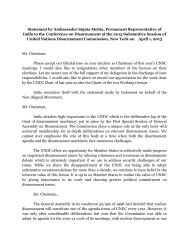
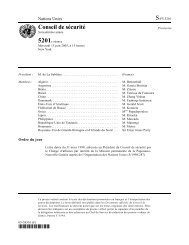
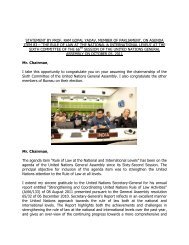
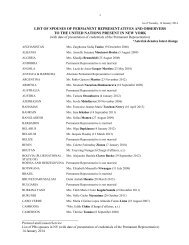
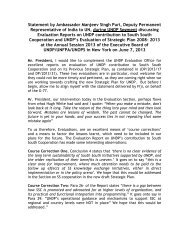
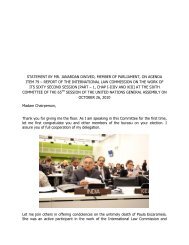
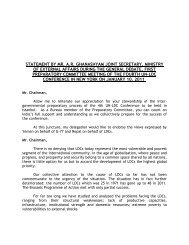
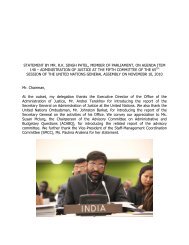

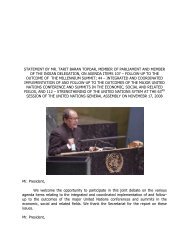
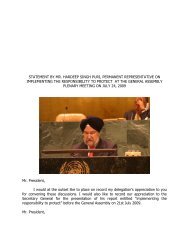
![1 statement by dr.[mrs] kakoli ghosh dastidar - Member States Portal](https://img.yumpu.com/27526598/1/190x245/1-statement-by-drmrs-kakoli-ghosh-dastidar-member-states-portal.jpg?quality=85)
